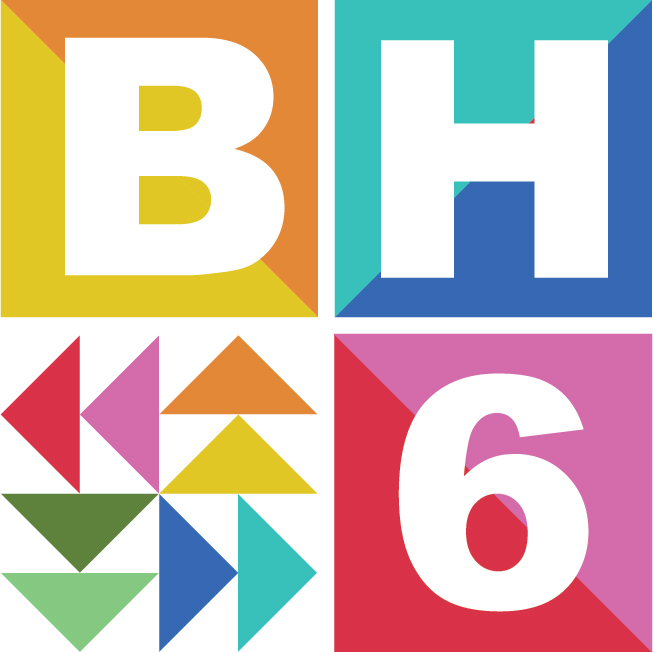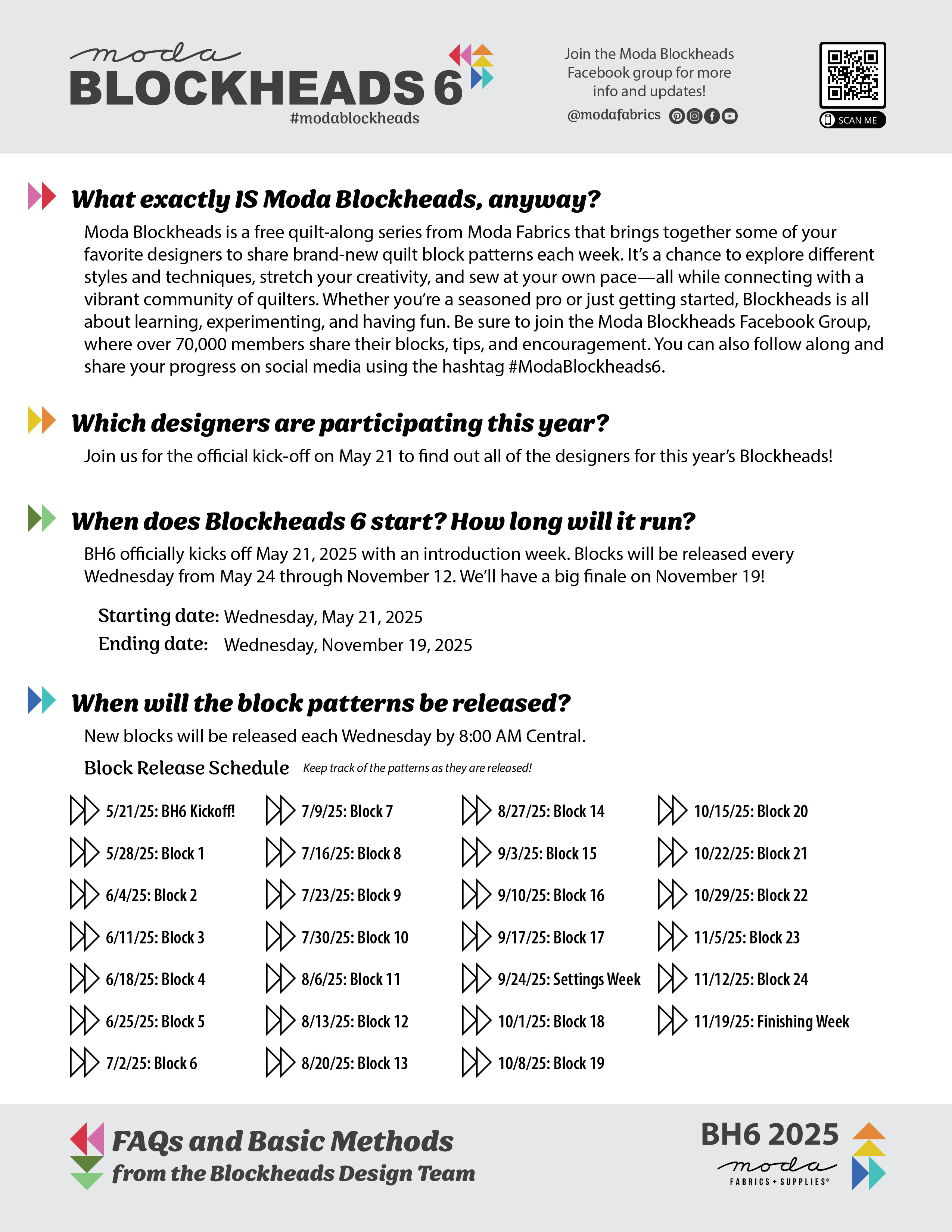Welcome to Moda Fabrics!
Get Ready for Blockheads 6!
Get Ready for Blockheads 6!
Get ready, quilters! The next round of Moda Blockheads is just around the corner, and we couldn’t be more excited to sew along with you. To help you prepare, we’ve rounded up some frequently asked questions about this fun, free block-of-the-week series—let’s dive in!

Download a printable version of these FAQs HERE.
What exactly IS Moda Blockheads, anyway?
Moda Blockheads is a free quilt-along series from Moda Fabrics that brings together some of your favorite designers to share brand-new quilt block patterns each week. It's a chance to explore different styles and techniques, stretch your creativity, and sew at your own pace—all while connecting with a vibrant community of quilters. Whether you're a seasoned pro or just getting started, Blockheads is all about learning, experimenting, and having fun. Be sure to join the Moda Blockheads Facebook Group, where over 70,000 members share their blocks, tips, and encouragement. You can also follow along and share your progress on social media using the hashtag #ModaBlockheads6.
Which designers are participating this year?
Join us for the official kick-off on May 21 to find out all of the designers for this year’s Blockheads!
When does Blockheads 6 start? How long will it run?
BH6 officially kicks off May 21 with an introduction week. Blocks will be released every Wednesday from May 24 through November 12. We’ll have a big finale on November 19!
Starting date: Wednesday, May 21, 2025
Ending date: Wednesday, November 19, 2025
When will the block patterns be released?
New blocks will be released each Wednesday by 8:00 AM Central.
Where can I download the patterns?
We will publish the pattern PDFs in two places: The Moda blog and the Moda Blockheads Facebook group.
Moda Inspiration + Resources
Each Wednesday morning, visit the Moda Inspiration + Resources blog for a post dedicated to that week’s block. In the blog post, we’ll share pics and links to the social media channels and website for the designer of the week. We hope you’ll visit the designer’s blog to learn more about them and their block! The blog post will also have a link to download the pattern PDF.
In addition to the block-specific blog posts every week, you can visit the Blockheads 6 Archive page for a complete list of the released block patterns, pattern corrections, and other updates:
https://my.modafabrics.com/inspiration-resources/blockheads-6-archive
Moda Blockheads Facebook group
If you’re a member of our Moda Blockheads Facebook group, you will also be able to download the weekly pattern on the Facebook group page by visiting the Files section of the group. The pattern files will also be available every Wednesday morning on Facebook.
Our designers are active on our Blockheads Facebook group and will be posting their blocks there as well, so you will definitely want to join the conversation there!
Will there be videos this year for each block?
Yes! Be sure to subscribe to the Moda Fabrics YouTube channel. We’ll have a new video for each block every week that will walk you through the block construction. We’ll share our sewing tips and tricks, as well as our favorite notions for making our Blockheads blocks.
What are the block sizes?
Unlike last year, BH6 will have different sizes for different blocks (instead of each block in two different sizes). The majority of the blocks will finish at 9”, while there will be a few 18” and even larger blocks!
What about setting options?
There will be at least 5 different settings to choose from! Several of the Blockheads designers will have setting options, and the Moda team is also providing settings.
How much fabric will I need?
That depends. Because this is a sampler quilt with different setting options, your actual fabric requirements will vary depending on how scrappy you would like to make your blocks, which setting you decide to use, whether you prewash and/or starch your fabrics, and other variables.
To make the just the 25 blocks in BH6, we recommend starting with about 30-35 assorted print fat quarters and 3-4 yards of background fabric. You may need to add more fabric depending on the setting you choose.
Several of us on the Moda team are making our Blockheads 6 blocks in Bella Solids; Moda Basics, including Grunge, Thatched, Eyelet, and Spotted; and Ruby Star Society Basics, including Starry and Speckled! If you’d like to work with Bella Solids and Basics for your Blockheads 6 blocks, we recommend selecting about 18-20 different Bellas and Basics and getting a range of 1/4-yard to 3/8-yard cuts.
I can’t wait to get started! How can I get ready for BH6?
Now is the perfect time to take care of a few pre-sewing preparations before we kick off BH6! Here are a few things we recommend before starting a new project:
-
Stock up on supplies
Visit your local quilt shop to replenish your supplies of starch, rotary cutter blades, needles, thread -
Sewing machine maintenance
Oil your machine, dust/clean out bobbin case, release your needle -
Fabric and cutting prep
Prewash or starch your fabrics, clean your iron, wash your ironing board cover, replace your rotary cutter blade -
Piecing prep
Prewind bobbins, test thread tension, test your seam allowance
About Seam Allowances
Unless specified otherwise, all seams will be sewn with a scant 1/4” seam.
What does that mean? It means that there is a difference between a perfect 1/4” seam, and one that is just a little bit less than that, one or two threads width smaller. When the edge of a ruler is placed on the edge of the fabric on a stitched seam, the stitching line should be just inside the 1/4” line. Why? That allows for the thickness of the fabric when it is pressed. There are many factors that can affect the size of the joined pieces, including the weight of the fabric, the weight/thickness of the thread being used, and whether the seams are pressed to one side or pressed open.
Can you rely on the 1/4” presser foot on a sewing machine? Some of the time. Many manufacturers now make presser feet that will result in an accurate scant 1/4” seam. Some machines also have a mark on the sewing machine throat plate as a guide for the fabric.
Does this all matter? Yes. While the first step to getting good results is a straight, consistent seam, piecing with a scant 1/4” seam allowance will result in greater accuracy, and blocks that are the same size, no matter how many seams are involved.
How can a thread’s width matter? A seam that is one or two threads bigger or smaller than ideal might amount to only 1/32”, but that’s on both sides of the seam, on each piece of fabric. That can add up to as much as 1/16”. Minor, right? Not noticeable. But when there are two or three seams joining a block, that can quickly be 1/8”. A few more seams and it can be 1/4”. That’s not a problem when all the blocks are similar, but when the blocks are a sawtooth star and a postage stamp block – two seams vs. nine seams across – one or two threads’ width difference quickly becomes a big variance in the size of the finished blocks. So achieving a perfect scant 1/4” seam allowance is time well-spent.
Making a Test Strip
Cut 3 strips of fabric – 1 1/2” x 3”. Join the three strips along the long edge. Press the seams to one side.
Measure the finished piece - it should measure 3 1/2” x 3”. If it’s less than 3 1/2”, the seam allowance is too big. If it’s more than 3 1/2”, the seam allowance is too small.
Pressing Seams Open
If you routinely press the seams open, make a second test strip using the same fabrics. Does it measure 3 1/2”? And is it the same size as the first test strip? It is worth making a second test strip just to see that there can be a difference.
How to Adjust the Seam Allowance
• Use a presser foot designed for quilting and a scant 1/4” seam allowance – and test it.
• Move the needle position.
• Use a stitching guide, e.g., Diagonal Seam Tape by Cluck Cluck Sew.
• Add a piece of tape to the plate of the machine to serve as a guide for fabric placement when stitching. (This is very “old-school,” a common practice before accurate presser feet made for quilting were available.)
Test Blocks
Making a test block is always a good idea. It’s even more so when the block uses a technique or method that is new. Just use some of your scraps.
• BH Tip: Make test blocks using the same color palette as a way of accumulating blocks for a seasonal or two-color sampler quilt.
Download the Blockheads 6 FAQs HERE.

